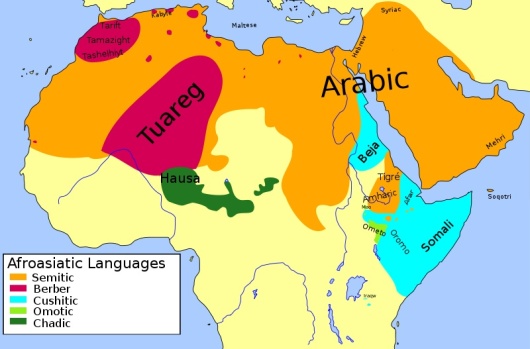In the world there are only a small number of large language families. In Africa, for example, there are four, Khoisan, Nilo-Saharan, Niger-Congo and Afro-Asiatic. In Europe there are three and if you count South Caucasian there are also four.
Afro-Asiatic is the language group to which e.g. the Semitic languages are classified. Arabic, Hebrew, Aramaic and so on are part of the Semitic branch of Afro-Asiatic. In North Africa old Egyptian or Coptic and the various Berber languages that were spoken in oases between eastern Egypt and Morocco are part of Afro-Asiatic. Tuareg is also a Berber language. One of the questions concerning Afro-Asiatic, is where it originated. Researchers differ strongly on this point. Some think that its origin was in the Eastern Sahara, others that it originated in East Africa, Egypt or Southwest Asia.
The question is interesting due to the emergence and spread of agriculture and cattle breeding. Did they arise independently in East Africa or were they brought here from Southwest Asia where agriculture first emerged, 13,000 years ago? Many African plants were domesticated in East Africa such as ensete (a root), teff (a grain) and noog , (an oil plant). The donkey, an African animal, was also domesticated here. Except for wheat and barley, few South-West Asian plants were grown in East Africa. Southwest Asian animals here were sheep, goats and cattle. However, it is not clear whether the East African package there was earlier than that from South-West Asia. If we would know where Afro-Asiatic originated this could contribute to the solution of the question of whether agriculture and cattle breeding were independently developed in East Africa.
In Africa there are several large Afro-Asiatic language groups: Tchadic in Central Africa, Omotic, Cushitic and Beja in East Africa. These groups count each dozens to more than 200 languages. These languages often differ greatly from each other which points to a very great antiquity. These Afro-Asiatic languages in African differ more amongst themselves than the Semitic that was spoken in Asia but also in Ethiopia and Eritrea. No one doubts that Semitic in Africa was imported from Yemen. The hypothesis that Afro-Asiatic was born in East Africa is mainly based on the observation that languages spoken in Central and East Africa show a much greater variety, and thus old age.
The linguists who state this thesis, however, hardly connect with what is known from history. Why would Afro-Asiatic have spread from here to North Africa and Southwest Asia? Such a big expansion cannot have accidental. It had to be based on advantages: further developed techniques, bigger fertility rates, better organization, better weapons. None of these points can be indicated for a possible extension of Afro-Asiatic from East Africa.
Today we have DNA analyses that have exposed the great migrations of people. In the past of this time frame little or no East-African DNA travelled to Southwest Asia. Some was found in Egypt and Yemen but in both cases, it is clear that this DNA travelled recently, mainly in the last three thousand years. The reverse however is true. South-West Asian DNA came to East and Central Africa spread quickly to West Africa. (Part two in the near future)
More on Afro-Asiatic?
The Problem of the Homeland of Afro-Asiatic (2) and the origin of agriculture
